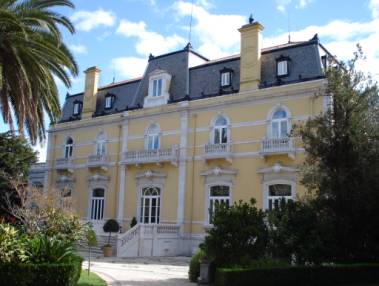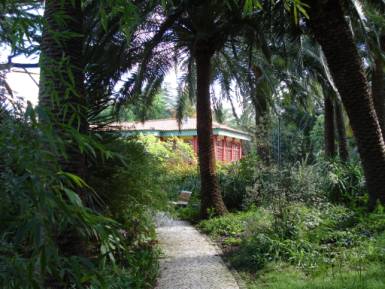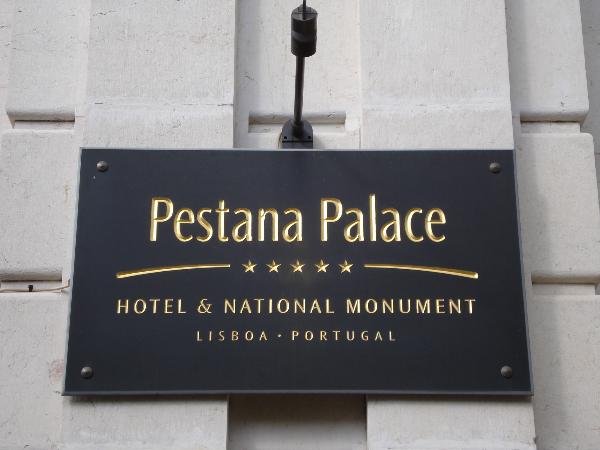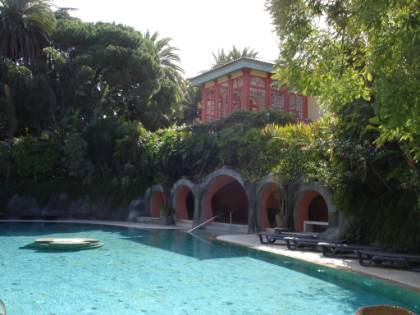
O Palácio do
Marquês de Valle Flor encontra-se situado na tranquilidade do Alto
de Santo Amaro, fora do emaranhado de ruelas do centro histórico de
Lisboa, assumindo-se como um verdadeiro "oásis urbano". Construído
no século XIX, o Palácio e os seus jardins foram restaurados e
classificados (desde 1997) como "Monumento Nacional". Actualmente
são parte integrante do Pestana Palace Hotel.

História
Este palácio
foi mandado construir por José Luís Constantino (1855-1932) natural
de Trás-os-Montes. De família de agricultores, em 1871 partiu para
S. Tomé e Príncipe, arquipélago português, situado no Equador e
descoberto, completamente desabitado, pelos navegadores João de
Santarém e Pedro Escobar, em 1471. Só a partir do século XIX se
consolida a sua exploração agrícola e organização territorial, que
conduz a um desenvolvimento sustentado, para o que muito
contribuíram homens como este, que foi, mais tarde Marquês de Valle
Flor por mercê do Rei D. Carlos I.

A sua
tenacidade e espírito empreendedor valeram-lhe a enorme fortuna.
Contribui para fazer de S. Tomé, entre 1912 e 1915, o primeiro
produtor mundial de cacau. A sua firme defesa desta colónia-fazenda
e fidelidade à política colonial valeu-lhe prestígio e ocupação de
múltiplos cargos ao serviço do Reino. Constrói este palácio no fim
do século XIX, princípio do século XX. O arquitecto italiano Nicola
Bigaglia está ligado ao projecto entre 1905 e 1906. O facto dos
Marqueses de Valle Flor estarem muito ligados a França e possuírem
um palacete em Paris não deixa de ser relevante como factor que
muito influenciou as opções decorativas e a selecção dos estilos,
que de modo eclético remetem principalmente para a época de Luís
XIV, Regência, Luís XV e Luís XVI. Palácio reflecte, assim, um
entrançado de vivências ancoradas em S. Tomé, Portugal e
França.

Com o
regicídio e implantação da Republica em 1910, o Marquês perdeu o
seu poder e título, mas não a fortuna que acumulara. Com a sua
morte, em 1932, o edifício envolveu-se num longo período em
silêncios e penumbras.
Depois de
mais de 50 anos ao abandono, o palácio foi adquirido em 1992 pelo
Grupo Pestana, que após um período de 5 anos de intenso trabalho de
restauro, devolveu as respectivas fachadas e interiores à sua
beleza e brilhantismo de outrora. Em 18 de Maio de 2001 é
finalmente inaugurado o Pestana Palace Hotel, membro da cadeia "The
Leading Hotels of the World".

Os
jardins
Os jardins do
Palácio Valle Flor foram delineados de acordo com o conceito de
"jardim paisagista", que pretende imitar a paisagem natural. Este
tipo de jardim, que se estende até final do século XIX, é inspirado
nas paisagens dos quadros de Claude Lorrain e Salvator Rosa, com a
inclusão de ruínas, templos, lagos, riachos, cascatas, grandes
relvados onde arbustos, espelhos de água e flores, colocados de
forma irregular nos traçados serpenteantes e sinuosos.

Nos jardins
do Palácio Valle Flor, optou-se pela regularidade e simetria, mas
também, um pouco pela fantasia e pitoresco, não fugindo ao estilo
ecléctico fin de siècle. Assim são visíveis influências do jardim
francês na zona junto à fachada principal e na alameda de palmeiras
que liga o Palácio à casa do jardim. Sebes de buxo delimitam
canteiros ou acompanham os declives do solo onde caminhos
pavimentados serpenteiam entre grande variedade de arbustos, flores
e árvores. A presença de plantas ornamentais e exóticas, zonas de
luz e sombra, texturas, cores e relvados, permitem imaginar o
espirito e estrutura inicial. Árvores que chegaram até aos dias de
hoje, tais como os cedros, as araucárias, tílias, grevíleas e
palmeiras, contribuem para a memória do jardim inicial. Também o
lago (agora uma piscina) e as esculturas representando as quatro
estações, enriquecem o envolvimento.

=========================================================================================
A
cache
A cache
encontra-se escondida nos jardins do Palácio, estando acessível
pelo caminho pavimentado, pelo que é de evitar pisar os canteiros
ou outros espaços ajardinados.
Evite
procurar esta cache durante a noite. Uma vez que o Palácio é agora
parte integrante de um hotel de luxo e charme, movimentações
nocturna suspeitas dentro dos jardins, podem ser notadas pelos
hóspedes e pessoal do hotel.
Procure esta
cache durante o dia e deixe-se levar pelo ambiente intimista e
sereno destes jardins. Aproveite também para visitar o interior do
Palácio, nomeadamente os seus salões, com decoração da época, de
influência francesa e oriental, revestimentos de mármore, frescos
nos tectos e paredes e janelas com grandes vitrais.
Atenção: a cache não tem material de escrita. Traga
um lápis ou caneta consigo.

The Palace of
the Marquis of Valle Flor is located in the quiet residential area
of Alto de Santo Amaro, outside the Lisbon' busy city centre,
standing as an authentic "urban refuge". Built on the 19th century,
the Palace and its gardens were restored and classified (since
1997) as "National Monument". At present they are part of the
Pestana Palace Hotel.
History
This Palace
was commissioned by José Luis Constantino (1855-1932), who was born
to a family of farmers from Trás-os-Montes, northeast of Portugal.
In 1871 he left to go to São Tomé e Principe, at the time a
Portuguese archipelago near the Equator, which had been discovered
totally uninhabited by the navigators João de Santarém and Pedro
Escobar in 1471. From the 19th century onwards, the archipelago
achieves a significant improvement in agriculture and land
management, which leads to sustained development. Many man
contributed to this, including Constantino, who later became
Marquis of Valle Flor by the appointment of King D. Carlos
I.
His tenacity
and enterprise earned him a great fortune. Between 1912 and 1915,
he made São Tomé the largest producer of cocoa in the world. His
firm defence of this plantation-colony, and his faithfulness to the
colonial policy earned him a great prestige and occupation of high
positions at the service of the Kingdom. He built this Palace in
the late 19th century and the beginning of the 20th. The Italian
architect Nicola Bigaglia worked on this project between 1905 and
1906. The Marquis of Valle Flor was closely associated with France
and he owned a small Palace in Paris. His contact with France
greatly influenced his choice of decoration and selection of styles
in the Lisbon Palace. These reflected the period of Louis XIV,
Regency, Louis XV and Louis XVI. The character of the Palace
reflects therefore, a combination of influences originating in São
Tomé, Portugal and France.
With the end
of the Monarchy and the establishment of the Republic in 1910, the
Marquis lost his power and title, but not his fortune. With his
death in 1932, the building fell into a state of silence and
darkness.
After over
fifty years of neglect, the Palace was bought in 1992 by Pestana
Group, which after a great deal of 5 years of meticulous
restoration work, has managed to return the facades and interior
areas to all their former beauty and brilliance. On May 18th, 2001,
the Pestana Palace Hotel, a member of "The Leading Hotels of the
World", is officially inaugurated.
The
gardens
The gardens
of Valle Flor Palace were designed according to the concept of the
"landscape garden", intending to imitate natural landscape. This
type of gardens that last until the end of the 19th century, is
inspired in the landscapes from the paintings of Claude Lorrain and
Salvator Rosa, with the introduction of ruins, temples, ponds,
streams, cascades, wide lawns where bushes, water mirrors and
flowers are placed irregularly on the sinuous and winding
traces.
The presence
of regularity and symmetry in the gardens of Valle Flor Palace,
along a little bit of fantasy and picturesque, is in accordance
with the eclectic style of the fin de siècle. Consequently, there
are influences from the French garden in the area by the main
façade and in the palm alley connecting the Palace to the garden
house. Box-tree edges circumscribe flower beds or stray along the
ground slopes, where paved paths wind among the great variety of
bushes, flowers and trees. Ornamental and exotic plants, areas of
light and shadow, textures and colours, lawns, recall the initial
spirit and structure. The trees that survived until today, such as
cedars, araucarias, linden trees, grevillias and palms contribute
to the memories of the initial garden. The pond (now a
swimming-pool) and the sculptures, which represent the four
seasons, enrich the surroundings.
=========================================================================================
The
cache
The cache is
hidden in the gardens of the Palace and can be accessed just by
walking on the paved path. Therefore, there is no need to step on
the flowerbeds and their surroundings.
Avoid
searching this cache at night. The Palace is now part of a luxury
and charm hotel, so any suspicious nocturnal movements within the
gardens can be noted by the guests and by the hotel
staff.
Search this
cache during the day and enjoy the intimate and serene environment
of the gardens. Take a visit to the interior of the Palace, namely
their salons, with decoration of the season, from French and Orient
influence and, coatings of marble, frescoes in the ceilings and
walls and windows with large stained glass.
Attention: The cache has no writing material. Bring
your own pencil or pen.